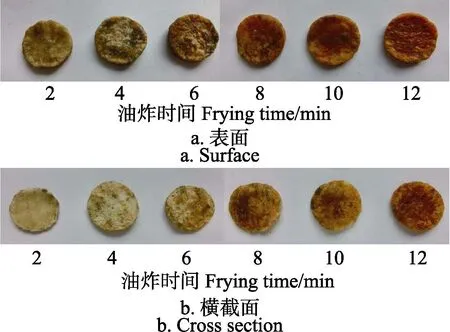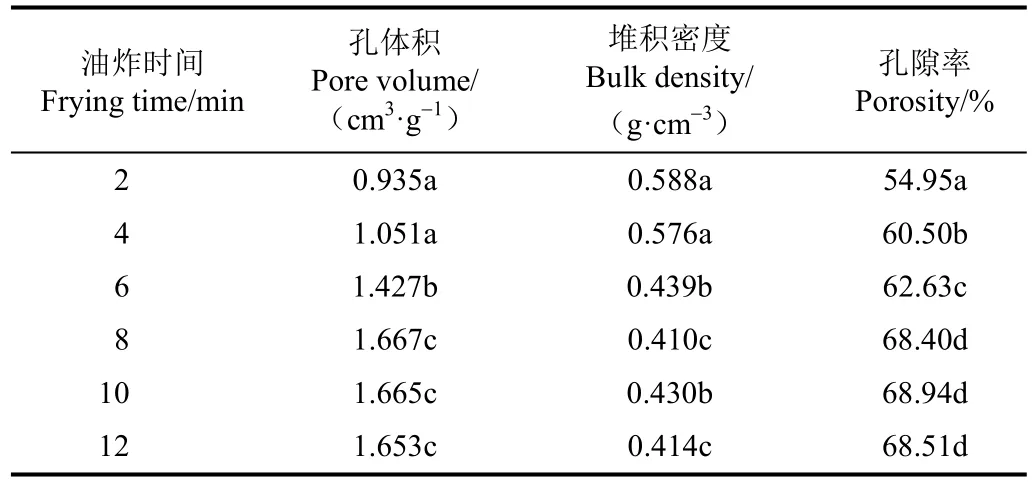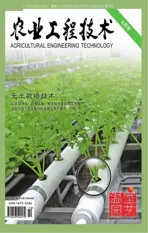不同油炸时间的马铃薯片油脂吸收规律
2017-07-07李进伟张婷婷刘元法范柳萍丁绍东
李进伟,王 敏,张婷婷,刘元法,范柳萍※,丁绍东
(1. 江南大学食品学院,无锡214122;2. 上海热丽科技集团有限公司,上海200125;3. 江南大学食品科学与技术国家重点实验室,无锡214122)
不同油炸时间的马铃薯片油脂吸收规律
李进伟1,王 敏2,张婷婷1,刘元法1,范柳萍1※,丁绍东3
(1. 江南大学食品学院,无锡214122;2. 上海热丽科技集团有限公司,上海200125;3. 江南大学食品科学与技术国家重点实验室,无锡214122)
为了表征不同油炸时间下马铃薯片的油脂吸收规律,该文结合索氏抽提、染色法、激光共聚焦扫描镜观察、低场核磁共振成像技术等方法对马铃薯片的油脂吸收规律进行描述和解释,获得了油炸温度180 ℃、油料比10:1时不同油炸时间下马铃薯片油脂含量、油脂类型以及油脂分布的变化规律,并结合其孔隙特征解释油脂的吸收行为。结果表明:油炸时间(0~12 min)显著影响马铃薯片的总油脂质量分数、表面油脂、结构油脂和表面渗透油脂质量分数(P<0.05);随着油炸时间的延长,马铃薯片的总油脂质量分数逐渐上升,当油炸10 min后,总油脂质量分数达到47.09%,之后逐渐趋于稳定;马铃薯片的表面油脂质量分数最低,约1.30%~2.06%;随油炸时间的延长,结构油脂质量分数逐渐上升,而油炸6 min后马铃薯片的表面渗透油脂质量分数呈下降趋势;激光共聚焦扫描镜观察显示,油炸过程中,随着油炸时间的延长,马铃薯片红色区域面积增大,表明油脂质量分数增加,且油脂从表面逐渐向中心渗透,黏附于细胞壁上,充盈细胞间质;当油炸时间为0~8 min时,马铃薯片的孔体积和孔隙率随油炸时间而增大,对应的油脂质量分数也逐渐提高,研究结果可为油脂吸收的表征,以及低油马铃薯片的开发提供参考。
油脂;食品加工;微观结构;油炸;油脂含量;孔隙特征
李进伟,王 敏,张婷婷,刘元法,范柳萍,丁绍东. 不同油炸时间的马铃薯片油脂吸收规律[J]. 农业工程学报,2017,33(10):310-314. doi:10.11975/j.issn.1002-6819.2017.10.041 http://www.tcsae.org
Li Jinwei, Wang Min, Zhang Tingting, Liu Yuanfa, Fan Liuping, Ding Shaodong. Oil absorption rule of fried potato chips during different frying time[J]. Transactions of the Chinese Society of Agricultural Engineering (Transactions of the CSAE), 2017, 33(8):310-314. (in Chinese with English abstract) doi:10.11975/j.issn.1002-6819.2017.10.041 http://www.tcsae.org
0 引 言
由于油炸过程的复杂性,油炸食品油脂吸收规律的研究几乎仅涉及油脂含量这个指标,但油脂吸收不仅仅是宏观上油脂含量的差异,还包括油脂进入样品内部的途径以及内部的分布等。有研究采用染色油法表征油炸食品中表面油脂、表面渗透油脂、结构油脂等油脂的不同吸收类型[1-3];随着显微镜技术的发展,激光共聚焦扫描显微镜(confocal laser scanning microscopy,CLSM)可用来分析油炸样品中微观油脂分布[4-8],以及细胞结构和孔隙结构,但其观察的范围有限;低场核磁共振(low field nuclear magnetic resonance,LF-NMR)成像技术可表征整个油炸样品油脂的宏观分布[9-12],该技术不仅可以反映油脂分布位置,也能够表征不同位置的油脂含量的差异,但仅局限于定性表征,只有联合油脂含量、油脂类型、油脂分布才可以较好地表征油炸过程中油脂的吸收行为。
油炸过程中,油炸时间、温度、压力、料液比等油炸条件影响果蔬脆片中油脂的含量与油脂吸收行为[13-16],目前研究油炸时间对油脂吸收影响的文献很多,何定兵等研究了土豆条油炸和冷却过程中组织结构含油量的变化,发现吸油过程主要是发生在冷却早期阶段[17];Su等发现,在土豆片微波辅助真空油炸过程中,较高的油炸温度和真空度会降低产品的含油率[18];但目前的结果仅仅是基于果蔬脆片中的总油脂含量,缺乏油脂分布、油脂类型的相关研究,导致油脂吸收行为的认识受到很大的局限。针对上述现状,本文利用染色法阐明了油炸过程中不同类型油脂的吸收规律,采用激光共聚焦扫描显微镜表征了油炸过程中油脂的吸收与分布特征,在此基础上,通过研究物料孔隙的变化规律,分析了油脂吸收与孔隙的相关性,研究结果对于油脂吸收规律的认识提供了较好的思路和方法。
1 材料与方法
1.1 材料与仪器
马铃薯,购于当地超市;棕榈油(起酥油),益海(广州)粮油工业有限公司;石油醚(30~60 ℃)、苏丹I、苏丹黑为分析纯试剂,国药集团化学试剂有限公司;尼罗红为分析纯试剂,日本东京化成工业株式会社。HH-S油炸锅,金坛市精达仪器制造厂;OX406脂肪测定仪,济南海能仪器股份有限公司;UV-2600紫外可见分光光度计,上海天美科学仪器有限公司;Quanta-200扫描电子显微镜,荷兰FEI公司;LSM710激光共聚焦显微镜,德国蔡司公司;MesoMR23-060H-I核磁共振成像分析仪,上海纽迈电子科技有限公司;Poremaster GT-60压汞仪,美国康塔仪器公司。
1.2 试验方法
1.2.1 马铃薯预处理
按前期预处理方法,马铃薯经挑选、清洗、去皮后,切成3 mm厚的薄片,然后用模具制成直径为22 mm的圆片,清洗后于沸水中漂烫3 min,冷却,得到新鲜马铃薯片[1]。
1.2.2 油炸过程
设置油炸锅油炸温度为 180 ℃下进行常压油炸,将制备好的新鲜马铃薯片于 1 000 mL棕榈油中(油料比10∶1)油炸 2、4、6、8、10、12 min。
按前期试验的方法制备与添加染色油[1-2],将 10.2 g苏丹I溶于1 L的起酥油中,在50 ℃下磁力搅拌直到其完全溶解,分装,冷藏,备用。在油炸过程结束前 20 s加入25 mL已预热到相同温度的染色油,搅拌均匀(在10 s内完成),取出样品。所有油炸样品从煎炸油中取出后,置于铁丝网上,于室温(25 ℃)下静态沥油10 min后,进行后续测定。
1.2.3 分析方法
总油脂和不同类型油脂含量的测定:总油脂(TO,total oil)含量根据索氏提取法测定;油炸样品的不同类型油脂即表面油脂(SO, surface oil)、表面渗透油脂(PSO,penetrated surface oil)和结构油脂(STO, structural oil)含量按前期[1-2]的方法测定。
宏观油脂分布的表征[19]:将不同样品于0.6 g/L的苏丹 I染色油中油炸不同时间,油炸前 20 s向其中加入10.2 g/L的苏丹黑染色油,搅拌均匀。油炸结束后取出样品,室温冷却10 min,用解剖刀于薯片中心横切或直接用数码相机拍照观察。
激光共聚焦扫描显微镜表征油脂分布[1]:将样品于0.019 2 g/L的尼罗红染色油中油炸,取出,如图1所示对样品不同部位进行横切或纵切,a表示薯片中心横切面的圆心处,b表示中心横切面的1/2半径圆周处,c表示中心横切面的圆周处,d表示中心纵切面的1/2半径处,用激光共聚焦扫描显微镜拍照观察。激发波长为514 nm,发射波长为598 nm;扫描深度180μm;在三维重建时,步长为0.45μm;图像处理使用Carl Zeiss LSM软件(ZEN 2012)。

图1 取样示意图Fig.1 Schematic diagram of sampling
核磁法表征油脂分布[19]:将油炸后的马铃薯片放入核磁共振成像分析仪的线圈中成像。线圈直径为25 mm,共振频率23.312 MHz,磁体强度0.5 T,磁体温度为32.00 ℃。
样品微观结构的观察[1]:采用扫描电镜分析马铃薯油炸样品的微观结构。将样品脱油去水后,固定于扫描电镜的专用样品套件上,在真空条件下进行表面镀金。将样品放于扫描电镜下观察,操作电压为5 kV。
样品孔隙结构的分析[19]:采用压汞仪测定样品微观孔隙结构,将脱油去水的样品切成长和宽均小于10 mm的小块,取7~8块样品置于压汞仪的样品腔中,其直径为10 mm,高度为20 mm。压力范围为0.006~69.431 MPa。压汞仪测试及数据处理使用Porowin软件。汞对大多数固体材料具有非润湿性,需外加压力才能进入固体孔中,汞能进入的孔的大小与压力符合Washburn方程,使用汞侵入法可以测定多孔物料的孔体积、堆积密度、孔隙率等物理特性。
1.3 数据分析
所有测定均重复3次,用SPSS17.0数据处理软件进行单因素方差分析(ANOVA),利用Duncan法分析差异显著性,显著性水平P=0.05。
2 结果与分析
2.1 不同油炸时间下马铃薯片油脂含量和油脂类型的变化
表面油脂指经冷却后黏附在样品表面的油脂;表面渗透油脂是指冷却过程中从表面吸入的油脂;结构油脂是指油炸过程中渗入油炸样品内部的油脂,它们共同构成了油炸样品的总油脂。图2显示了在180 ℃下油炸不同时间的油炸马铃薯片的总油脂含量和不同类型油脂含量变化曲线。可以看出,油炸时间显著影响总油脂含量、表面油脂、结构油脂和表面渗透油脂含量(P<0.05)。在油炸2 min时,总油脂质量分数上升至40.44%,油炸10 min时,总油脂质量分数达到47.09%,且在前10 min,总油脂含量随着油炸时间的增加而增加。在3种类型油脂中,表面油脂质量分数最低,约1.30%~2.06%,其含量随着油炸时间的增加而降低。结构油脂质量分数在2~10 min时显著上升,从6.44%上升到25.13%。而Bouchon等[20]报道的结构油脂含量却很低,约 0.4%。这可能是因为在他们研究中是以较大尺寸的马铃薯条(长 5.1 cm,直径1.075 cm)为试验对象,且油炸时间较短(5 min)。表面渗透油脂含量在2 min时最大,随后降低。这可能是因为随着油炸过程的继续,油炸样品水分含量减少,水蒸汽压对结构油脂的阻滞作用减弱,导致越来越多的结构油脂占据了样品内部的孔洞结构,结构油脂含量增加,在冷却过程中,由表面渗入内部的表面渗透油脂反而减少[1]。在油炸后期(10~12 min),总油脂和其组成油脂(表面油脂、结构油脂和表面渗透油脂)含量保持恒定。
马铃薯片在不同油炸时间下苏丹 I+苏丹黑双染色效果从图 3中可以看出,随着油炸时间的延长,样品表面和横截面越来越红,这说明在总油脂中结构油脂所占比例越来越大;在最初的6 min,样品表面较黑,而横截面黑色较少,油脂渗入较少,说明油炸前期,表面渗透油脂含量较大,结构油脂含量较少。

图2 油炸时间对油炸马铃薯片油脂质量分数的影响Fig.2 Effect of frying time on oil contents of fried potato chips

图3 不同油炸时间的马铃薯片苏丹I+苏丹黑染色油脂分布Fig.3 Oil distribution of fried potato chips dyed with Sudan I and Sudan black at different frying times
2.2 不同油炸时间下马铃薯片油脂分布的变化
用激光共聚焦扫描与低场核磁共振成像分析技术研究不同油炸时间下马铃薯片的油脂分布。图 4为油炸马铃薯片激光共聚焦扫描显微镜的三维图,图中红色代表油脂分布区。当油炸时间为2 min时,a列中几乎观察不到油脂,这说明此时煎炸油还未进入样品中心。比较前6 min的a、b、c列图片,在同一油炸时间点下,c列油脂分布最多,b列其次,a列最少,这说明油脂为从外向内的渗入顺序。由单层图可以看出,油炸4 min时,b列上的马铃薯片内部细胞较为完整,因为此时的马铃薯片内部水分含量仍然较高。另从该图像中可以观察到油脂沿着细胞的形态轮廓进行分布,黏附于细胞壁上,充盈细胞间质,Pedreschi等[21]和Bouchon等[22]观察到了类似的现象。对油炸前8 min的样品图片进行纵向比较,可以看出,随着油炸时间的增加,油脂渗入样品内部越来越多,在10~12 min时,渗入内部的油脂增加不明显,这与图 2显示的定量结果相吻合。从纵切图片中也可以看出,随着油炸时间的增加,渗入样品内部的油脂越来越多,且样品内部孔洞逐渐形成,该微观结构的形成可能是由于油炸过程中水蒸汽压的急剧增大,从而导致细胞的变形和坍塌[23-25]。
低场核磁共振成像分析技术可以宏观表征油脂的分布状况。但由于核磁法测样品的油脂分布只适用于含水率低于 15%的样品。由于低含水率的薯片样品中水分含有结合水,衰减很快,弛豫时间很短,仪器成像时只采集到油脂的信号,得到的图像只显示油脂的分布。对于2 min和4 min样品,由于含水率大于15%(初始含水率86.46%,油炸2min时为44.52%, 4min为15.14%),所以图5只展示了6~12 min的油炸马铃薯片的核磁图像,其对应的含水率为4.41%~1.24%。核磁图像不仅可以用颜色的差异来反映油脂信号的强弱,即红色表示油脂含量高,蓝色表示油脂含量低,而且可以直观地表征油炸马铃薯片的整体油脂分布情况。从图 5可以看出,随着油炸时间的增加,油脂信号越来越强,这表明随着油炸时间的增加,样品油脂含量越来越高。所以利用核磁法测定的薯片样品的油脂吸收情况,其变化趋势与图 2的定量结果基本一致。Hickey等[26]也发现核磁法得到的结果与已知的样品油脂含量一致性较好。随着油炸过程的继续,油脂不仅仅分布在外表壳层,样品内部的信号逐渐增强,油脂逐渐渗入油炸样品内部,这与结构油脂变化趋势一致。而Macmillan等[9]发现油脂只分布在壳层里,这是因为他们选择的油炸样品中心仍存在水分,而本文 10~12 min的油炸样品已达到水分的平衡点(1.24%)。在油炸过程中,分布在边缘壳层的油脂含量始终高于其他位置,这是因为边缘壳层的孔体积较大,且与油脂直接接触,从而较多的油脂分布其中[5,27]。

图4 不同油炸时间的马铃薯片油脂分布激光共聚焦扫描显微镜三维图Fig.4 CLSM 3D images of oil distribution of fried potato chips of different frying times

图5 不同油炸时间的油炸马铃薯片油脂分布低场核磁图Fig.5 LF-NMR images of oil distribution of fried potato chips of different frying times
2.3 不同油炸时间下马铃薯片微观结构的变化
油炸马铃薯片扫描电镜如图6显示,在油炸4 min时,样品表面皱缩;8 min时,油炸马铃薯片表面有轻微凸起现象。这可能是由于随着油炸过程的继续,水分蒸发层由外向内迁移,4 min时表面水分尚未蒸发完全,8 min时,内部水分的剧烈蒸发而产生了巨大的蒸汽压使表面轻微膨胀。在8 min和10 min时,油炸样品表面仍可以观察到连续、完整、紧绷的细胞结构。Kalogianni等的研究中[23]也观察到类似的现象。

图6 不同油炸时间马铃薯片表面扫描电镜图(放大倍数100倍)Fig.6 SEM images of fried potato chips surface of different frying times (×100 times)
2.4 不同油炸时间下马铃薯片孔隙结构的变化
表 1显示了不同油炸时间的马铃薯片中孔隙的宏观参数,包括孔体积、堆积密度和孔隙率。在油炸前8 min,随着油炸时间的增加,马铃薯片的孔体积和孔隙率逐渐升高,堆积密度逐渐降低。Adedeji和Ngadi[28]也同样发现油炸样品的堆积密度随着油炸时间的增加而降低。油炸8 min以后,油炸样品的孔体积、堆积密度和孔隙率逐渐趋于稳定。在油炸前期(0~6 min),水分蒸发剧烈,形成的压力较大,导致此阶段样品内部孔隙结构变化较大,但由于水分含量较高,油脂难以进入样品内部,结构油脂含量增加缓慢;在8 min时,此时的水分蒸发速率很小,样品内部孔隙结构基本形成,结构油脂和总油脂达到较高值;在10 min时,内部吸油达到平衡,此时样品可容纳油脂的空间基本饱和,油脂含量趋于稳定;孔隙参数反映的孔结构的变化,其随时间的变化规律与油脂吸收规律相一致,孔体积、孔隙率越大,对应的油脂含量越高[7,29]。

表1 油炸时间对油炸马铃薯片孔隙宏观参数的影响Table 1 Effect of frying time on macroscopic pore structure parameters of fried potato chips
3 结 论
1)当油炸温度180℃,油料比10∶1时,油炸时间(0~2min)显著影响马铃薯片的总油脂质量分数、表面油脂、结构油脂和表面渗透油脂质量分数(P<0.05)。在 3种类型油脂中,表面油脂质量分数最低,约 1.30%~2.06%,其质量分数随着油炸时间的增加而降低;结构油脂质量分数在 2~10 min时显著上升,从 6.44%上升到25.13%;表面渗透油脂质量分数在2 min时最大,随后降低。
2)马铃薯片油炸过程中,油脂呈现从外向内的渗入顺序,从样品的外表壳层逐渐向内部渗入,且油脂沿着细胞的形态轮廓进行分布,黏附于细胞壁上,充盈细胞间质;样品中心的油脂含量低于外部边缘壳层。
3)不同油炸时间下油脂的吸收过程,孔体积和孔隙率越大,对应的油脂含量越高。
[1]Zhang T T, Li, J W, Ding, Z S, et al. Effects of initial moisture content on the oil absorption behavior of potato chips during frying process[J]. Food Bioprocess Technology,2016, 9(2): 331-340.
[2]张婷婷,俞琳,丁占生,等. 油炸时间和温度对模拟马铃薯片油脂吸收的影响[J]. 食品工业科技,2015,36(13):49-52.Zhang Tingting, Yu Lin, Ding Zhansheng, et al. Effect of frying temperature and time on oil absorption of simulated potato flakes[J]. Science and Technology of Food Industry,2015, 36(13): 49-52. (in Chinese with English abstract)
[3]Rahman M S, Sablani S S. Structural characteristics of freeze-dried abalone: porosimetry and puncture test[J]. Food and Bioproducts Processing, 2003, 81(C4): 309-315.
[4]Dueik V, Moreno M C, Bouchon P. Microstructural approach to understand oil absorption during vacuum and atmospheric frying[J]. Journal of Food Engineering, 2012, 111(3): 528-536.
[5]朱瑶迪,邹小波,申婷婷,等. 油炸藕片含油量快速预测及微观结构的三维重建[J]. 农业工程学报,2016,32(5):302-306.Zhu Yaodi, Zou Xiaobo, Shen Tingting, et al. Rapid detection of oil content and 3-dimensional reconstruction of microstructure of fried lotus root[J]. Transactions of the Chinese Society of Agricultural Engineering (Transactions of the CSAE), 2016,32(5): 302-306. (in Chinese with English abstract)
[6]朱瑶迪,邹小波,赵杰文,等. 油炸方式对油炸藕片吸油率与微观结构的影响[J]. 农业机械学报,2015,46(6):201-211.Zhu Yaodi, Zou Xiaobo, Zhao Jiewen, et al. Research of oil uptake and distribution of fried lotus root slices based on confocal laser scanning microscopy[J]. Transactions of the Chinese Society of Agricultural Machinery, 2015, 46(6):201-211. (in Chinese with English abstract)
[7]Moreno M C, Bouchon P. Microstructural characterization of deep-fat fried formulated products using confocal scanning laser microscopy and a non-invasive double staining procedure[J]. Journal of Food Engineering, 2013, 118(2):238-246.
[8]Gibis M, Schuh V, Weiss J. Effects of carboxymethyl cellulose (CMC) and microcrystalline cellulose (MCC) as fat replacers on the microstructure and sensory characteristics of fried beef patties[J]. Food Hydrocolloids, 2015, 45(3): 236-246.
[9]Macmillan B, Hickey H, Newling B, et al. Magnetic resonance measurements of French fries to determine spatially resolved oil and water content[J]. Food Research International, 2008, 41(6): 676-681.
[10]Martínez-Yusta A, Guillén M D. Deep-frying. A study of the influence of the frying medium and the food nature, on the lipidic composition of the fried food, using 1H nuclear magnetic resonance[J]. Food Research International, 2014,62(11): 998-1007.
[11]Oztop M H, Bansal H, Takhar P, et al. Using multi-slicemulti-echo images with NMR relaxometry to assess water and fat distribution in coated chicken nuggets[J]. LWT-Food Science and Technology, 2014, 55(2): 690-694.
[12]张晨芳,门玲,谭思敏,等. 油炸时间和温度对椰味面包罗非鱼品质的影响[J]. 食品工业科技,2016,37(16):264-268.Zhang Chenfang, Men Ling, Tan Simin, et al. Effect of frying times and temperatures on the quality of coconut breaded tilapia fillets[J]. Science and Technology of Food Industry,2016, 37(16): 264-268. (in Chinese with English abstract)
[13]Zeng H, Chen J, Zhai J, et al. Reduction of the fat content of battered and breaded fish balls during deep-fat frying using fermented bamboo shoot dietary fiber[J]. LWT-Food Science and Technology, 2016, 73(11): 425-431.
[14]Albertos A B, Martin-Diana I, Jaime A M, et al. Protective role of vacuum vs. atmospheric frying on PUFA balance and lipid oxidation[J]. Innovative Food Science & Emerging Technologies, 2016, 36(8): 336-342.
[15]Cortés P, Segura L, Kawaji M, et al. The effect of gravity on moisture loss and oil absorption profiles during a simulated frying process using glass micromodels[J]. Food and Bioproducts Processing, 2015, 95(7): 133-145.
[16]Teruel M R, García-Segovia P, Martínez-Monzó J, et al. Use of vacuum-frying in chicken nugget processing[J]. Innovative Food Science & Emerging Technologies, 2014, 26(12):482-489.
[17]何定兵,徐斐,华泽钊,等. 降低油炸土豆制品吸油率方法与机理研究[J]. 农业工程学报, 2012,28(3):278-281.He Dingbing, Xu Fei, Hua Zezhao, et al. Oil absorption reducing method and mechanism of fried potatoes[J].Transactions of the Chinese Society of Agricultural Engineering (Transactions of the CSAE), 2012, 28(3): 278-281. (in Chinese with English abstract)
[18]Su Y, Zhang M, Zhang W, et al. Application of novel microwave-assisted vacuum frying to reduce the oil uptake and improve the quality of potato chip[J]. LWT-Food Science and Technology, 2016, 73(11): 490-497.
[19]张婷婷. 基于水分和孔隙的马铃薯脆片油脂吸收行为分析[D]. 无锡:江南大学,2016.Zhang Tingting. Effects of Moisture and Pore on the Oil Absorption Behavior of Potato Chips[D]. Wuxi: Jiangnan University, 2016. (in Chinese with English abstract)
[20]Bouchon P, Aguilera J M, Pyle D L. Structure oil-absorption relationships during deep-fat frying[J]. Journal of Food Science, 2003, 68(9): 2711-2716.
[21]Pedreschi F, Aguilera J M, Arbildua J J. CLSM study of oil location in fried potato slices[J]. Microscopy and Analysis,1999, 37: 21-22.
[22]Bouchon P, Hollins P, Pearson M, et al. Oil distribution in fried potatoes monitored by infrared microspectroscopy[J].Journal of Food Science, 2001, 66(7): 918-923.
[23]Kalogianni E P, Papastergiadis E. Crust pore characteristics and their development during frying of French-fries[J].Journal of Food Engineering, 2014, 120(1): 175-182.
[24]Kassama L S, Ngadi M O. Pore development and moisture transfer in chicken meat during deep-fat frying[J]. Drying Technology, 2005, 23(4): 907-923.
[25]Dana D, Saguy I S. Mechanism of oil uptake during deep-fat frying and the surfactant effect-theory and myth[J]. Advances in Colloid and Interface Science, 2006, 128(12): 267-272.
[26]Hickey H, Macmillan B, Newling B, et al. Magnetic resonance relaxation measurements to determine oil and water content in fried foods[J]. Food Research International,2006, 39(5): 612-618.
[27]Lisińska G, Gołubowska G. Structural changes of potato tissue during French fries production[J]. Food Chemistry,2005, 93(4): 681-687.
[28]Adedeji A A, Ngadi M. Characterisation of pore properties of deep-fat-fried chicken nuggets breading coating using mercury intrusion porosimetry technique[J]. International Journal of Food Science and Technology, 2010, 45(11):2219-2226.
[29]Ziaiifar A M, Courtois F, Trystram G. Porosity development and its effect on oil uptake during frying process[J]. Journal of Food Process Engineering, 2010, 33(2): 191-212.
Oil absorption rule of fried potato chips during different frying time
Li Jinwei1, Wang Min2, Zhang Tingting1, Liu Yuanfa1, Fan Liuping1※, Ding Shaodong3
(1.Food Science and Technology, Jiangnan University, Wuxi214122,China; 2.Shanghai Reli Technology Group Co., Ltd.,Shanghai200125,China; 3.State Key Laboratory of Food Science and Technology, Jiangnan University, Wuxi214122,China)
In order to characterize the oil absorption behavior of potato chips during the different frying time, the soxhlet extraction, dye method, confocal laser scanning microscopy and low field nuclear magnetic resonance imaging were combined to analyze and explain the oil absorption behavior of potato chips in this paper. When the frying temperature was 180 ℃ and the ratio of oil to material was 10:1, the changing rules of oil content, oil type and oil distribution of potato chips during the different frying time were obtained. In addition, the porosity characteristics of potato chips were also used to explain the oil absorption behavior during frying. The results showed that frying time (0-12 min) significantly affected the content of total oil,surface oil, structural oil and surface penetrated oil of potato chips at the frying temperature of 180 ℃ and the ratio of oil to material of 10:1 (P<0.05). The total oil content of potato chips increased with the increase of frying time. When the frying time reached 10 min, the total oil content of potato chips was 47.09%, and then it gradually tended to be stable. The surface oil content of potato chips was the lowest, which was about 1.30%-2.06%. The structural oil content of potato chips increased with the increase of frying time, however the PSO content of potato chips decreased when the frying time exceeded 6 min. The confocal laser scanning microscopy showed that during the frying process, the red region of potato chips enlarged with the increase of frying time, which meant the increase of the oil content of potato chips. The oil was permeated from the surface of the potato slice to the interior and located on cell walls, which followed the cell shapes and filled the intercellular spaces.When the frying time was 0-8 min, the pore volume and porosity increased with the increase of frying time, and the oil content of potato chips was also increased. Overall, this study has an important significance for the characterization of oil absorption behavior of potato chips during the frying process. Besides, it provides reliable data and effective means for the development of potato chips with the lower oil content.
oils and fats; food processing; microstructure; frying; oil content; pore character
10.11975/j.issn.1002-6819.2017.10.041
TS255
A
1002-6819(2017)-10-0310-05
2016-10-25
2017-04-09
“十三五”国家重点研发计划(2016YFD0401404)、国家自然科学基金(31371812)江苏省重大科技示范项目(BE2016635)联合资助
李进伟,男,山西朔州人,副教授,博士,主要从事食品科学研究。无锡 江南大学食品学院,214122。Email:jwli@jiangnan.edu.cn;
※通信作者:范柳萍,女,山西祁县人,教授,博士,博士生导师,主要从事食品科学研究。无锡 江南大学食品学院,214122。
Email:fanliuping@jiangnan.edu.cn
